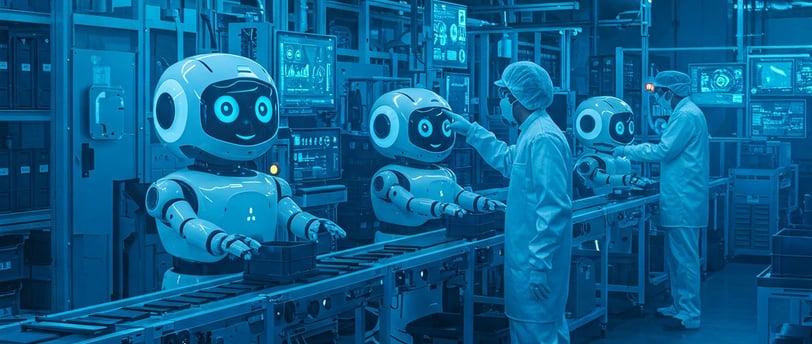Embracing Industry 5.0 & the Human Element
Industry 5.0 is a human-centric approach to manufacturing that combines human creativity with advanced technologies. It requires a multifaceted approach to upskilling the workforce, addressing ethical considerations and fostering human-robot collaboration. Discover how to navigate these challenges and build a more sustainable, equitable and prosperous future for all.
INDUSTRY REIMAGINED
Snehanshu Jena
1/5/20252 min read


While Industry 4.0 focused on automation and connectivity, Industry 5.0 takes a significant leap forward by emphasizing the collaboration between humans and machines. It's about creating a more sustainable, human-centric and resilient ecosystem where technology empowers and complements human capabilities, rather than replacing them. This shift requires a multifaceted approach:
1. Upskilling the Workforce:
Industry 5.0 demands that the workforce is equipped with the skills and knowledge to thrive in a technologically advanced environment. This goes beyond basic digital literacy and involves:
Technical Skills: This requires providing training on AI and its applications, robotics, data analysis and programming which empowers employees to understand, interact with and even develop AI-powered solutions.
Cognitive Skills: It involves fostering critical thinking, problem-solving and creativity. These skills become even more crucial as we assign AI to take routine/repetetive and low value tasks, allowing humans to focus on higher-level thinking and innovation.
Social and Emotional Skills: As human-machine collaboration becomes the norm, the ability to effectively communicate and work in teams, both with humans and AI agents, will be essential. Developing communication, collaboration and emotional intelligence will be really important.
2. Ethical Considerations:
The rise of AI brings with it a host of ethical considerations that must be addressed proactively:
Bias in Algorithms: AI algorithms are trained on data. If that data reflects existing biases, the AI system can perpetuate and even amplify those biases. This can lead to unfair or discriminatory outcomes. Addressing this requires diverse and representative datasets, rigorous testing and ongoing monitoring of AI systems for bias.
Data Privacy: Industry 5.0 relies heavily on data, raising concerns about the privacy and security of personal information. Implementing robust data governance policies, ensuring compliance with data protection regulations and promoting transparency in data usage are crucial.
Impact of Automation on Employment: While AI can create new jobs and opportunities, it can also lead to job displacement in certain sectors. Addressing this requires proactive measures such as reskilling initiatives, social safety nets and policies that promote a just transition for workers.
3. Human-Robot Collaboration:
Industry 5.0 envisions a future where humans and robots work together seamlessly, leveraging the unique strengths of each. This requires:
Intuitive Interfaces: This includes natural language processing, gesture recognition and augmented reality overlays that provide real-time information and guidance. Hence we will need to design user-friendly interfaces that enable humans to easily interact with and control robots.
Collaborative Robots (Cobots): Cobots are equipped with safety features such as force sensors and collision avoidance systems, to ensure safe and efficient collaboration. This is really essential for developing robots that are specifically designed to work alongside humans in a shared workspace.
Optimized Workflows: There is a need to redesign workflows to optimize human-machine interaction. It involves identifying tasks that are best suited for humans (Ex: tasks requiring creativity, dexterity or complex decision-making) and those that are best suited for robots (Ex: repetitive, physically demanding or hazardous tasks).
In essence, Industry 5.0 is not just about technological advancement; it's about creating a future where technology serves humanity. By prioritizing human well-being, ethical considerations and collaborative ecosystems, we can unlock the true potential of Industry 5.0 and build a more sustainable, equitable and prosperous future for all.
